According to researchers, the Gaia space telescope, observing billions of stars, can see traces of a wandering black hole. But it looks like there’s nothing like that in the latest data release.

How to see an invisible black hole?
Scientist Jeff Andrews from the University of Florida says that the Gaia space telescope could find signs of single black holes wandering around our Galaxy. Until now, people have seen signs of only those objects of this type that form binary systems with stars or supermassive monsters in the centers of galaxies.
However, one wandering black hole was recently identified according to 2011 data. This discovery became a sensation and still causes controversy. There should be hundreds of millions of such objects in the Milky Way, but since they emit almost nothing, they can only be seen when they pass between some star or us.
The article published by Andrews is already the third in the cycle. The first considered a way by which scientists can, according to Gaia data, find invisible components in vision. The second was devoted to data analysis for those cases when the interaction between components exceeds the observation time. This time the study is devoted directly to finding black holes.
Will Gaia see wandering black holes?
The passage of a black hole in front of a star is a rare phenomenon. But the Gaia Space Telescope observes hundreds of millions of astronomical objects every day, determining their spectrum, luminosity and motion vector. Andrews’ idea is that among such a huge array of information there should be cases when the apparent motion of a star unexpectedly accelerated for a short time.
Recently, the Gaia telescope team produced a third data release. It contains information about 1.5 billion stars of our galaxy. And among them, about 300 thousand cases of such acceleration were actually detected.
But this effect can be given not only by wandering black holes. The same can happen when stars interact with dark matter. And estimates of the spread of this exotic form of matter in the Milky Way give approximately the same estimate in 300 thousand cases of acceleration.
So, even if there are 1-2 cases in the Gaia data when a wandering black hole has given itself away, it will be very difficult to find them.
According to www.universetoday.com
Follow us on Twitter to get the most interesting space news in time
https://twitter.com/ust_magazine

